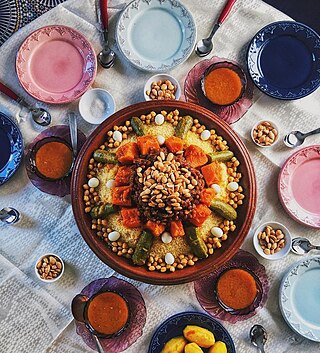Related Research Articles

Couscous is a traditional North African dish of small steamed granules of rolled semolina that is often served with a stew spooned on top. Pearl millet, sorghum, bulgur, and other cereals are sometimes cooked in a similar way in other regions, and the resulting dishes are also sometimes called couscous.

Millets are a highly varied group of small-seeded grasses, widely grown around the world as cereal crops or grains for fodder and human food. Most millets belong to the tribe Paniceae.

The Reuben sandwich is a North American grilled sandwich composed of corned beef, Swiss cheese, sauerkraut, and Russian dressing or Thousand Island dressing, grilled between slices of rye bread. It is associated with kosher-style delicatessens but is not kosher, as it combines meat and cheese.

A dosa, dosey, dosai, dosha is a thin, savoury crepe in Indian cuisine made from a fermented batter of ground black gram and rice. Dosas are served hot, often with chutney and sambar. Dosas are a common food in South India and North Sri Lanka.

Pastrami is a type of cured meat originating from Romania usually made from beef brisket. The raw meat is brined, partially dried, seasoned with herbs and spices, then smoked and steamed. Like corned beef, pastrami was created as a way to preserve meat before the invention of refrigeration. One of the iconic meats of Eastern European cuisine as well as American Jewish cuisine and New York City cuisine, hot pastrami is typically served at delicatessen restaurants on sandwiches such as the pastrami on rye.

Moussaka is an eggplant (aubergine)- or potato-based dish, often including ground meat, which is common in the Balkans and the Middle East, with many local and regional variations.

Pearl millet is the most widely grown type of millet. It has been grown in Africa and the Indian subcontinent since prehistoric times. The center of diversity, and suggested area of domestication, for the crop is in the Sahel zone of West Africa. Recent archaeobotanical research has confirmed the presence of domesticated pearl millet on the Sahel zone of northern Mali between 2500 and 2000 BC. 2023 was the International Year of Millets, declared by the United Nations General Assembly in 2021.

Garlic chutney, also referred to as lahsun chutney, lahsun ki chutney, lehsun chutney and bellulli chutney, is a chutney, originating from the Indian subcontinent, made from fresh garlic, dry or fresh coconut, groundnuts and green or red chili peppers. Cumin and tamarind are also sometimes used as ingredients. It is prepared in both wet and dried forms. The wet variety is made with fresh grated coconut and is typically served immediately after preparation.

Matzah balls or matzo balls are Ashkenazi Jewish soup morsels made from a mixture of matzah meal, beaten eggs, water, and a fat, such as oil, margarine, or chicken fat. Known as knaidel in Yiddish, they resemble a matzah meal version of knödel, bread dumplings popular throughout Central European and East European cuisine.

A flatbread is bread made usually with flour; water, milk, yogurt, or other liquid; and salt, and then thoroughly rolled into flattened dough. Many flatbreads are unleavened, although some are leavened, such as pita bread.

Reuben's Restaurant and Delicatessen was a restaurant and Jewish deli in Manhattan, New York City founded by Arnold Reuben.

Jollof, or jollofrice, is a rice dish from West Africa. The dish is typically made with long-grain rice, tomatoes, chilis, onions, spices, and sometimes other vegetables and/or meat in a single pot, although its ingredients and preparation methods vary across different regions. The dish's origins are traced to Senegal.

Peanut stew or groundnut stew, also known as maafe, sauce d'arachide (French) or tigadèguèna is a stew that is a staple food in Western Africa. While maafe is a dish from Senegal, tigadéguéna originates from the Mandinka and Bambara people of Mali.

West African cuisine encompasses a diverse range of foods that are split between its 16 countries. In West Africa, many families grow and raise their own food, and within each there is a division of labor. Indigenous foods consist of a number of plant species and animals, and are important to those whose lifestyle depends on farming and hunting.

Balep korkun or Yosang balep is a type of bread that is consumed mainly in central Tibet. It is round, flat and relatively easy to make. The ingredients are tsampa, water and baking powder. It is cooked in a frying pan. It has been described as similar in appearance to naan.

Cuisine in Mali includes rice and millet as staples of Mali, a food culture heavily based on cereal grains. Grains are generally prepared with sauces made from edible leaves, such as spinach, sweet potato or baobab, with tomato peanut sauce. The dishes may be accompanied by pieces of grilled meat.

Injera is a sour fermented pancake-like flatbread with a slightly spongy texture, traditionally made of teff flour. In Ethiopia and Eritrea, injera is a staple. Injera is central to the dining process in Amhara community, like bread or rice elsewhere and is usually stored in the mesob.

Pastrami on rye is a sandwich comprising sliced pastrami on rye bread, often served with mustard and Kosher dill pickles. It was popularized in the Jewish delicatessens of New York City and has been described as New York's "signature sandwich". It was created in 1888 by the Lithuanian immigrant Sussman Volk, who served it at his deli on Delancey Street in Manhattan.

A Jewish deli, also known as a Jewish delicatessen, is a store that serves various traditional dishes of Jewish cuisine, mostly Ashkenazi Jewish cuisine. Known for their robust sandwiches, such as pastrami on rye, they also specialize in traditional Jewish diaspora soups and other ethnically rooted dishes. As retail delicatessens, most also sell a selection of their products such as sliced meats by the pound, prepared salads, pickles, and offer dine-in or take-out.
References
- ↑ Chris Ying; René Redzepi; MAD (2 October 2018). You and I Eat the Same: On the Countless Ways Food and Cooking Connect Us to One Another (MAD Dispatches, Volume 1). Artisan. p. 26. ISBN 978-1-57965-856-4.
- ↑ Avani Burdett. Delicatessen Cookbook - Burdett's Delicatessen Recipes: How to make and sell Continental & World Cuisine foods. Springwood emedia. p. 14. ISBN 978-1-4761-4462-7.
- ↑ Encyclopedia of Food Chemistry. Elsevier Science. 22 November 2018. pp. 2–. ISBN 978-0-12-814045-1.
- ↑ Hungry Planet: What the World Eats. Social Studies. 2007. p. 579. ISBN 978-1-56004-298-3.
